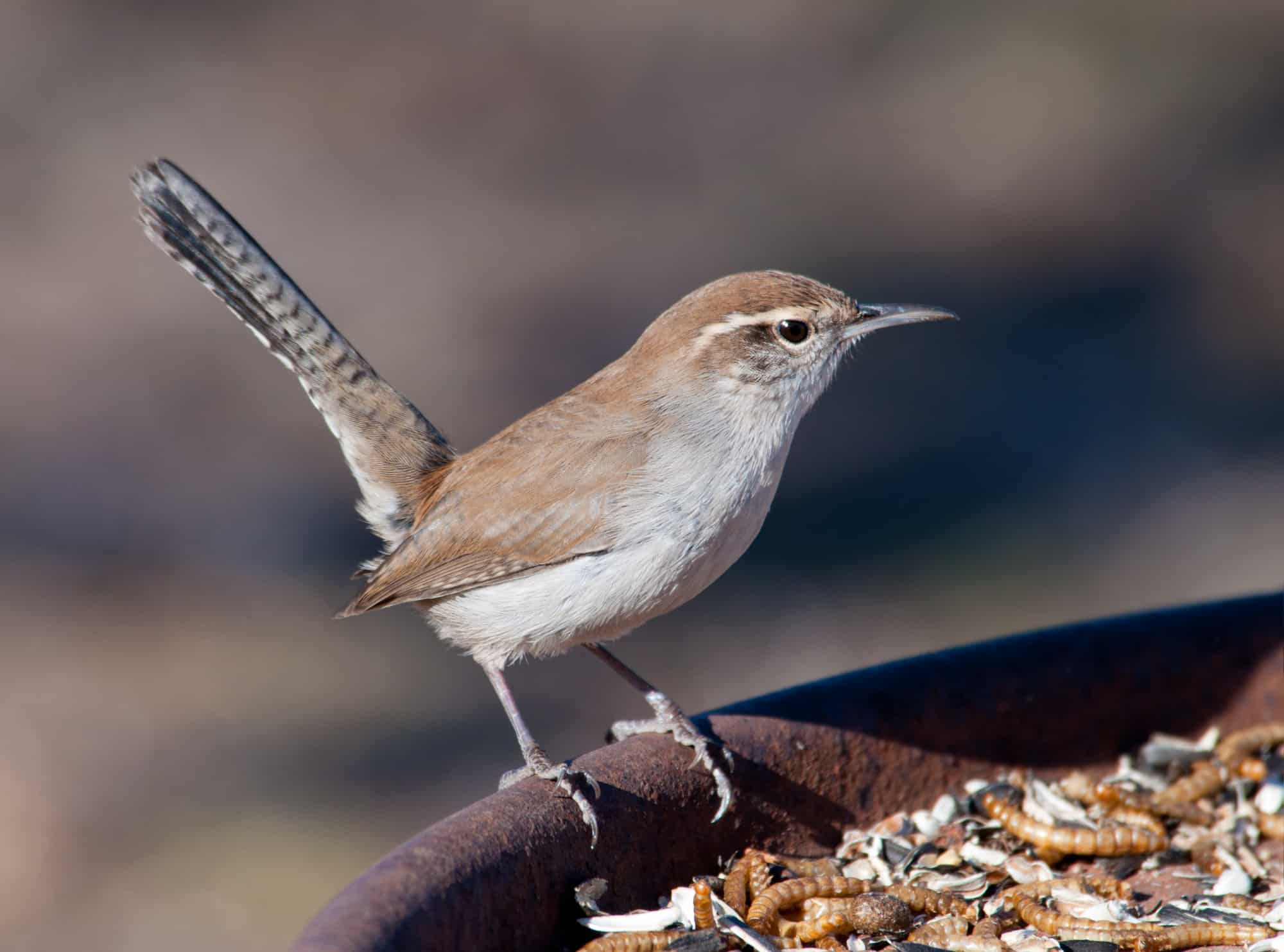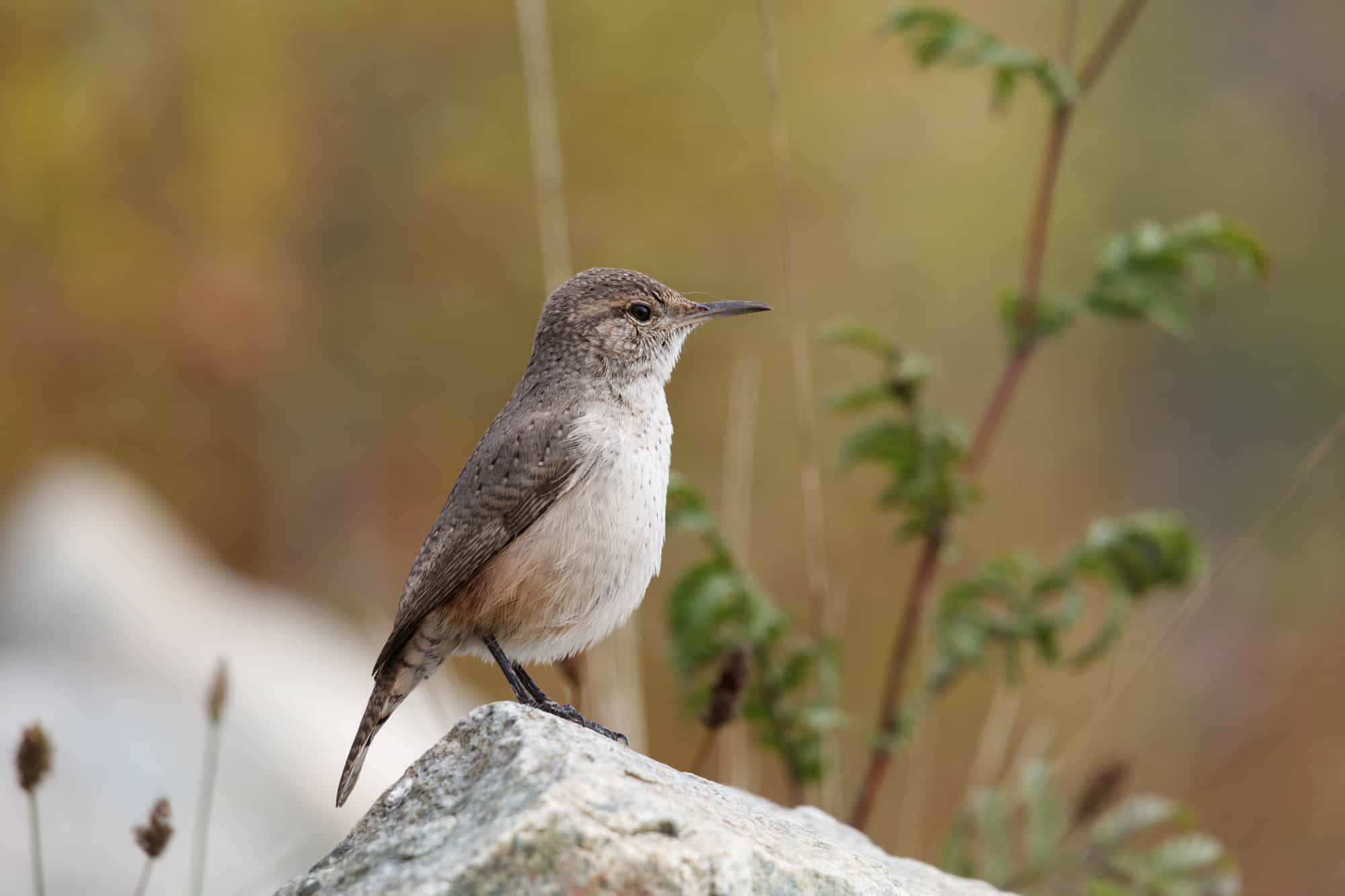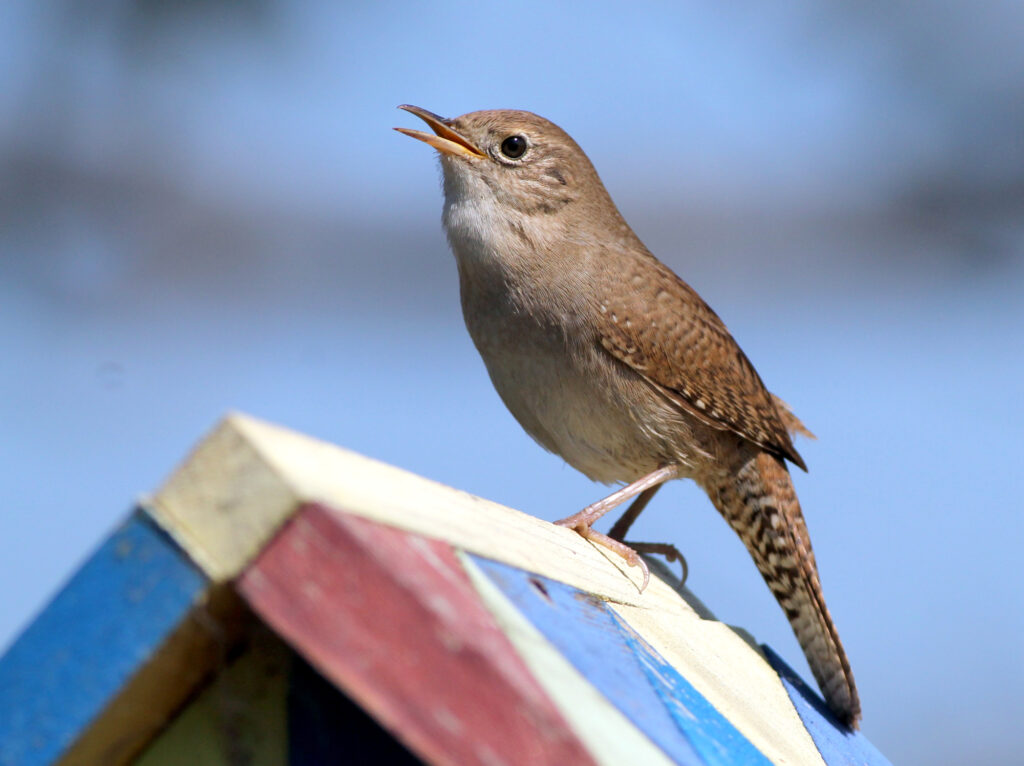Wrens are a family of small, lively songbirds that bring energy and personality to backyards and natural areas across Illinois. With their upright tails, busy habits, and loud melodic songs, wrens are a delight to encounter for bird enthusiasts who know where and how to spot them.
There are 5 species of wrens that either reside in Illinois seasonally or reside here all year. While not the flashiest or most abundant family of birds, wrens have an endearing quality and are fairly common in the right habitats.
Our list of wrens also includes 2 rarely-spotted visitors to Illinois, but we’ll get to those birds at the end of our list!
First: What Makes a Wren a Wren?
Let’s begin with some background on these charming creatures.
Wrens get their name from the Greek word “troglodyte” meaning “cave-dweller”, referring to the enclosed, dome-shaped nests they build for raising young.
In terms of physical features, wrens are mostly brown, gray, or rufous in color with paler bellies and darker wings and tails. They have plump, rounded bodies measuring just 4 to 8 inches in length. Their tails are usually carried cocked upright at an angle and their bills are fairly long and slender for probing into vegetation and crevices.
Wrens have a reputation for being active, energetic foragers. They are constantly rustling through leaves and branches in search of spiders and insects, rarely sitting still for long. You’ll often see them hopping along the ground or flitting through bushes with quick, choppy wing beats. Their movements have an almost acrobatic quality.
In addition to their active nature, wrens are also quite vocal. They belt out loud, complex songs and calls from hidden perches within dense bushes. Their voices seem disproportionately large for their bodies! Wren songs are often described as rattling trills, buzzy, or guttural. There are also regional dialects between species. Learning their various vocalizations is key to identifying them.
Personality-wise, wrens are generally curious, expressive, and incredibly territorial. They use their songs not only to attract mates but also to vigorously defend their nesting and feeding grounds from intruders. You’ll often hear two wrens sing-shouting back and forth at each other from nearby bushes.
Regarding habitat, wrens appreciate dense, brushy areas near woods, backyard thickets, overgrown fields, and marshes. They especially like tangled spots where they can duck out of sight from potential predators. Yet with some patience, they can become fairly comfortable around people.
Useful Tips for Spotting Wrens in Illinois
If you want to learn to identify wrens in Illinois, we have some tips to help get started!
- Head out during the early morning or late afternoon when they are most actively singing and foraging. Sit and listen quietly for their trademark rattling trills.
- Invest in a good pair of binoculars and practice using them beforehand. Many wrens hide amongst the dense brush, which makes them tricky to spot through the foliage.
- Download a bird ID app like Merlin that contains wren songs and location guides. This will aid with identifying species.
- Note physical features like size, bill shape, plumage patterns, tail shape, wing bars, eye stripes, etc. Details are key for making an ID.
- Pay attention to behaviors like foraging style, territorial singing, wing flicks, tail movements, interactions, and flight patterns.
- Record the date, time, location, and habitat whenever you spot one. If you keep a birding journal, you can even look for annual patterns in their arrivals and departures.
- You can also use your journal and fill it with detailed notes, sketches, and vocalization clips to refresh your memory.
- Respect wildlife by keeping your distance and never disturbing nests or young. Follow birding ethics and leave no trace.
- Join your local Audubon chapter or birding Facebook group to connect with fellow enthusiasts. Share your wren experiences and sightings!
As you spend more time watching and listening, you’ll get better at recognizing wrens by sight and sound. Their appearances, behaviors, and habitats will become familiar over time. The key is being patient, quiet, and alert.
Wrens bring such dynamism and personality to backyards, parks, and wild spaces. With some diligent observation guided by the tips above, you’ll be able to distinguish their singing, identify species, and track their movements throughout the seasons.
Soon you’ll come to know these little birds on an intimate level as you immerse yourself in the wondrous world of Illinois wrens!
Wrens in Illinois All Year
The only kind of wren that stays in Illinois all year is the nonmigratory Carolina Wren.
Carolina Wren

- Scientific Name: Thryothorus ludovicianus
- Order: Passeriformes
- Family: Troglodytidae
- Length: 4.7-5.5 in (12-14 cm)
- Weight: 0.6-0.8 oz (18-22 g)
- Wingspan: 11.4 in (29 cm)
Meet the cute little Carolina Wren!
The Carolina Wren displays reddish-brown plumage with a streaked white tail and wings. This small bird maintains an upright posture, and its tail usually points upwards at an angle.
The fastest way to recognize the Carolina Wren is to look for its distinctive white eyebrow stripe, which extends far past its eyes toward the back of its head. Most wrens, including the Carolina Wren, are sexually monomorphic, which means that males and females look alike and are generally not distinguishable from one another. That is unless, of course, you see them exhibit behavior associated with their sex, such as incubating eggs or feeding their young.
Carolina Wrens are widespread throughout all of Illinois. They may be less populous along the northern border of the state, but in general, they are easy to find here, as well as in the rest of the US Midwest and Southeast.
They favor a combination of habitats, including shrubby areas, woodlands, and suburban neighborhoods and parks. They are especially adept at living close to lots of human activity. They will often build their nests near outbuildings and residential neighborhoods, although they protect themselves by staying hidden among brushy thickets and overgrown farmland.
Interesting facts about the Carolina Wren:
- The Carolina Wren is one of the only fully non-migratory wrens in North America. They occupy a wide range from the middle of the US to the East Coast, and from the Great Lakes to Florida.
- They eat a lot of insects and spiders, but they will sometimes eat small amounts of fruit.
- Their nests are dome-shaped and are usually built about 3-4 feet above the ground. They will nest in shrubs and small trees, as well as in flower pots, old work boots, unused propane and charcoal grills, etc.
- Carolina Wrens are fierce little birds. To protect his habitat, the male Carolina Wren will fly fast through the air, creating a whooshing sound with his feathers. He will slam directly into a tree (especially a palmetto in the south) to make a loud, intimidating sound.
Wrens in Illinois for the Summer
There are more wrens in Illinois in the summertime than at any other point in the year. In addition to the Carolina Wren, who stays put all year, you can find the House Wren, Marsh Wren, and Sedge Wren in Illinois during the summer. This is where they find a mate, build a nest, lay their eggs, and raise their hatchlings.
House Wren

- Scientific Name: Troglodytes aedon
- Order: Passeriformes
- Family: Troglodytidae
- Length: 4.3-5.1 in (11-13 cm)
- Weight: 0.3-0.4 oz (10-12 g)
- Wingspan: 5.9 in (15 cm)
Because the House Wren is so widespread across North America, this is the bird that many people think of first when we talk about wrens.
House Wrens have plain brown coloring with lighter feathers on their undersides. They keep their tail cocked upwards most of the time, which gives them an alert and attentive appearance. Their only distinctive markings are the very light black bars on their wings and back.
House Wrens are found in almost all of South America and North America. They spread across most of the US during the summer, where they look for a variety of habitats, including deciduous forests, swamps, conifer forests, aspen groves, and rural farms and buildings.
In South America, they live at heights of up to 10k feet above sea level, which means the only place they avoid is the upper heights of the Andes Mountains.
They are found throughout Illinois all summer long. Look for them in barns, flower pots, rafters, and more.
Interesting facts about the House Wren:
- House Wrens have a diverse diet, which consists of insects and spiders such as beetles, earwigs, daddy longlegs, caterpillars, flies, and others. Additionally, they consume snail shells, likely for the calcium and grit they provide, which helps with good digestion.
- Male House Wrens display an intriguing behavior of constructing “dummy nests,” also known as false nests or phantom nests. These nests are loosely built and lack the characteristic hollowed-out cavity for the female to lay her eggs. Researchers speculate that this behavior serves either as a way to protect his territory uniquely or as a means of providing potential mates with multiple nesting options. If the female selects one of these dummy nests, she will rebuild it entirely (this is different from some other wrens, who just move right in!).
- Similar to other wren species in our list, House Wrens are opportunistic nesters. They make use of various nesting sites, including birdhouses, tree cavities, little crevices in buildings, treehouses, playgrounds, and empty pots.
Marsh Wren

- Scientific Name: Cistothorus palustris
- Order: Passeriformes
- Family: Troglodytidae
- Length: 4.3-5.1 in (11-13 cm)
- Weight: 0.3-0.4 oz (10-12 g)
- Wingspan: 5.9 in (15 cm)
The Marsh Wren, a delightful little bird, boasts a unique appearance with a distinguishable white line above its eye and black and brown streaks adorning its back. Its tail is often held upright, accompanied by short wings and a slender bill.
These charming avian creatures can be spotted in various aquatic habitats, including marshes and wetlands, across North America. Their behavior leans towards secrecy, as they prefer hiding amidst dense vegetation and reeds. This keeps them safe from predators.
Marsh Wrens breed in the wetlands of Illinois, building their nests directly into the tall grasses of the marshlands where they live. Their nests are attached to multiple reeds or grasses at the same time.
Interesting facts about the Marsh Wren:
- Marsh Wren males showcase their impressive nest-building skills, crafting multiple nests throughout the breeding season, sometimes constructing as many as 22. That’s because they build up to 6 nests for each of the females they mate with (as you can tell, Marsh Wrens are non-monogamous). These nests serve both territorial purposes and as a means to impress potential mates.
- In their marshy homes, Marsh Wrens primarily feast on insects, spiders, and other small invertebrates found in the marshy environments.
- One of the delights of the Marsh Wren is its enchanting, bubbly song that resonates through the wetland surroundings. Males are known for their complex songs, which they use to attract mates and establish their territories within the marshlands.
Sedge Wren

- Scientific Name: Cistothorus platensis
- Order: Passeriformes
- Family: Troglodytidae
- Length: 3.9-4.7 in (10-12 cm)
- Weight: 0.3-0.3 oz (7-10 g)
- Wingspan: 4.7-5.5 in (12-14 cm)
With its blend of black, rufous, and brown plumage, the petite Sedge Wren is a handsome little bird. A wash of yellow gives its feathers a distinctive hue, while its top sports darker shades compared to the pale belly. To spot this species, look for the white chin and buffy brow that stripe its face. Also note the short, curved bill and upward-cocked tail that are classic wren features.
True to its name, the Sedge Wren nests among tall stands of sedges, choosing meadows, marshes, prairies, and hayfields with wet, scrubby vegetation. Though it resides in wetlands, this wren avoids deeper marshes, unlike its cousin the Marsh Wren. Long legs suited to grasping provide an advantage while foraging amidst its grassy domicile.
Come summer breeding season, Sedge Wrens spread across the central Canadian provinces and America’s Midwest heartland. By winter they retreat to the balmier Southeast states, migrating back north when warmer weather returns.
They are relatively widespread across most of Illinois, but Southern Illinois only sees them when they migrate through in the spring and fall.
Interesting facts about the Sedge Wren:
- The Sedge Wren feeds mostly on insects and spiders snatched from the vegetation of its habitat. At times, the Sedge Wren may also eat seeds and berries.
- In keeping with the talents of the wren family, the Sedge Wren is a virtuoso vocalist. It makes numerous whistles and buzzes. Males sing to mark territory and woo females. However, these wrens stay hidden amidst the grass and sedge, eluding detection even while singing boldly.
Wrens in Illinois During the Winter
There is only one kind of wren that lives in Illinois during the winter: the conveniently named Winter Wren.
Winter Wren

- Scientific Name: Troglodytes hiemalis
- Order: Passeriformes
- Family: Troglodytidae
- Length: 3.7-4.3 in (9.5-11 cm)
- Weight: 0.3-0.4 oz (7-12 g)
- Wingspan: 5.9 in (15 cm)
A plump little ball with a short, uptilted tail, the Winter Wren sports rich brown plumage marked by darker barring on its wings and tail. Tiny and elusive, it keeps to the shadows, making it tough to spot this furtive creature.
In summer these wrens breed in Canada’s northern reaches and the upper United States before wintering in the southeastern states and Mexico.
Winter Wrens migrate through the northern part of Illinois and spend the winter in the rest of the state. You are most likely to find them near forest streams. Watch for them among fallen logs and trees.
Interesting facts about the Winter Wren:
- Although they mainly consume insects and spiders, they vary their diet during non-breeding months, adding fruits and seeds to the menu.
- For such diminutive birds, they have outstanding voices and sing intricate, melodious songs to claim turf and find mates. Their powerful trills are a bit surprising coming from such tiny birds!
- Scouring the ground among fallen leaves for meals, they forage primarily in the understory of their forest habitats.
Wrens That Have Been Spotted in Illinois
Sometimes, a bird will end up off its migration path and get lost. Alternatively, a bird can be considered rare in Illinois because it has become endangered. That’s the story with our next two birds. The Bewick’s Wren is an endangered bird in Illinois that has lost its habitat to the House Wren. Rock Wrens are rare vagrants that have accidentally ended up in many different states over the years.
Bewick’s Wren

- Scientific Name: Thryomanes bewickii
- Order: Passeriformes
- Family: Troglodytidae
- Length: 4.7 in (12 cm)
- Weight: 0.4-0.6 oz (12-18 g)
- Wingspan: 7.1 in (18 cm)
With its distinctive white brow stripe and upward-cocked tail, the delicate-looking Bewick’s Wren boasts plumage of chocolate brown on top that fades to pale gray on the underside. They live in a variety of habitats, including both open land and scrubby thicketed areas. They live in evergreen forests, deserts, and suburban gardens.
They are primarily western dwellers across the United States and Canada, and they stay year-round in many areas. Some groups undertake short migrations.
In Illinois. the Bewick Wren’s original territory has been taken over by House Wrens, and they are now endangered in the state. They are rarely spotted during the summer months in the Southeastern corner of Illinois.
Interesting facts about the Bewick’s Wren:
- It feeds on insects, spiders, and tiny invertebrates foraged from diverse habitats including woodlands, meadows, and suburban gardens.
- Renowned for complex songs mixing beautiful whistles and trills, it is highly vocal, using melodious calls to communicate and guard territory.
- The Bewick’s Wren constructs elaborate domed nests from twigs, grass, and feathers. It tucks these nests into tree hollows, old nests, and even human-made structures. The male starts the nest-building, and his mate helps.
Rock Wren

- Scientific Name: Salpinctes obsoletus
- Order: Passeriformes
- Family: Troglodytidae
- Length: 5.1-5.5 in (13-14 cm)
- Weight: 0.4-0.6 oz (12-17 g)
- Wingspan: 8.7 in (22 cm)
With its intricate brown-barred plumage on top and pale speckled underside, the gray-colored Rock Wren is a charming species that rarely makes its way to Illinois. It has a slim bill for snatching insects and a slightly upturned tail.
Their natural habitat is made up of the rugged cliffs, stony outcrops, canyons, and deserts of western North America. If you spot a Rock Wren east of the Mississippi, you should contact your local birding community to document the sighting, as they are rare outside of the western half of the US and Central Mexico.
The Rock Wren is a mostly nonmigratory species, but some do travel. When they migrate, they might travel a short or long distance. If they get caught up in strong headwinds or a storm, they can end up far outside of their typical range. That is how they end up in places like Illinois, where it has only been spotted a handful of times.
Interesting facts about the Rock Wren:
- When not hunkered down in rocky crevices, the Rock Wren sings its warbling melody. Songs establish breeding territories and attract potential mates.
- They build their nests in crevices, holes, and under rocky ledges. Sometimes they will nest in old, stone buildings or fences, and very rarely, they will pick an abandoned tree cavity.
More Birds To Find in Illinois
In addition to finding wrens in Illinois, there are many other amazing birds in the state. Wild Bird Scoop has put together guides for several types of birds that you can find in the state. These guides are full of details, pictures, and information about each bird.
Here’s what we have to date:

